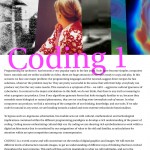
Programming for architects has become a very popular topic in the last years. Tools have become simpler, computers faster, tutorials and are online available as video, there are huge amounts of examples ready to copy and play. In this
scenario we face one major problem: the programming languages and the tutorials suggest direct recipes for fast solutions, whatever the problem may be. They are pretty successful in the sense that with their help, everybody can produce very fast the very same results. This scenario is a symptom of the – we call it – aggressive cultural ignorance of cybernetics. In contrast to the major articulations in this field, we do not think, that there is any truth or meaning in what a program can produce. Even if our algorithms generate forms that look strangely familiar to us, because they resemble some biological or natural phenomena, they are not cracking some immediate code of nature. In what computers can produce, we find a mirroring of the categories of our thinking, knowledge, and our tools. If we take code for natural in any sense, we are heading towards a naked and most extreme reductionist functionalism.
To bypass such un-ingenuous schematism, his module sets out with cultural, mathematical, and technological implications contained within the different programming paradigms to develop a rich understanding of the power of coding. Coding means orchestrating cultural déjà vus. By coding we are sheaving rich symbolizations to work within a digital architectonics that is constituted by our assignations of value to the old and familiar, as articulations for attention within an open competition among our contemporaries.
CODING I is a 4 week course and will concentrate on the media of digital graphics and images. We will exercise different levels of abstraction towards images, to get an understanding of different ways of thinking that have evolved throughout the past centuries. This path will leas us from magnitude to what we call multitudes, and on to the contemporary indexes whose subsumption can be understood as potitudes. CODING II will follow the same didactical line, but concentrate on 3D objects and vectors. It will linke more directly to traditional CAAD and computer architecture. The emphasis on images as objects of our exercises in CODING is chosen because this is technically less challenging and therefore suitable for a first round of this challenging program. The exercises are in Processing and Java.

